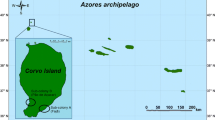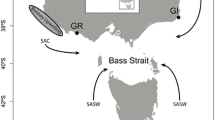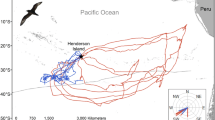Abstract
Foraging spatial segregation is frequent in central-place foragers during the breeding season, but very few studies have investigated foraging spatial segregation between adjacent sub-colonies. Here, we assessed for within-colony differences in the at-sea distribution, habitat use, trophic ecology and chick growth data of two Calonectris colonies differing in size, and breeding in two different environments in the North Atlantic Ocean. For this, we GPS tracked 52 Cory’s shearwaters (Calonectris borealis) breeding in 2 small sub-colonies at Berlenga Island (Portugal) and 59 Cape Verde shearwaters (Calonectris edwardsii) breeding in 2 sub-colonies differing greatly in size at Raso Islet (Cabo Verde), over 2 consecutive breeding seasons (2017–2018), during chick-rearing. Cory’s shearwaters from the two sub-colonies at Berlenga Island broadly overlapped in repeatedly used foraging patches close to the colony. In contrast, the foraging distribution of Cape Verde shearwaters was partially segregated in the colony surroundings, but overlapped at distant foraging areas off the west coast of Africa. Despite spatial segregation close to the colony, Cape Verde shearwaters from both sub-colonies departed in similar directions, foraged in similar habitats and exhibited mostly short trips within the archipelago of Cabo Verde. These results, corroborated with similar trophic ecology and chick growth rates between sub-colonies, support the idea that foraging spatial segregation in the colony surroundings was not likely driven by interference competition or directional bias. We suggest that high-quality prey patches are able to shape travel costs and foraging distribution of central-place foragers from neighbouring sub-colonies.





Similar content being viewed by others
Availability of data and material
GPS tracking data are available through the BirdLife International Seabird Tracking Database (http://www.seabirdtracking.org) under IDs: 1059 and 1440.
References
Aarts G, Mul E, Fieberg J et al (2021) Individual-level memory is sufficient to create spatial segregation among neighboring colonies of central place foragers. Am Nat 198:E37–E52. https://doi.org/10.1086/715014
Abecassis M, Senina I, Lehodey P et al (2013) A model of loggerhead sea turtle (Caretta caretta) habitat and movement in the oceanic North Pacific. PLoS ONE 8:e73274. https://doi.org/10.1371/journal.pone.0073274
Ainley DG, Ribic CA, Ballard G et al (2004) Geographic structure of Adélie penguin populations: overlap in colony-specific foraging areas. Ecol Monogr 74:159–178. https://doi.org/10.1890/02-4073
Araújo MS, Bolnick DI, Layman CA (2011) The ecological causes of individual specialisation. Ecol Lett 14:948–958. https://doi.org/10.1111/j.1461-0248.2011.01662.x
Ashmole NP (1963) The regulation of numbers of tropical oceanic birds. Ibis 103b:458–473. https://doi.org/10.1111/j.1474-919X.1963.tb06766.x
Beal M, Oppel S, Handley J et al (2021) track2KBA: an R package for identifying important sites for biodiversity from tracking data. Methods Ecol Evol. https://doi.org/10.1111/2041-210X.13713
Bogdanova MI, Wanless S, Harris MP et al (2014) Among-year and within-population variation in foraging distribution of European shags Phalacrocorax aristotelis over two decades: implications for marine spatial planning. Biol Conserv 170:292–299. https://doi.org/10.1016/j.biocon.2013.12.025
Bolnick DI, Svanbäck R, Fordyce JA et al (2003) The ecology of individuals: incidence and implications of individual specialization. Am Nat 161:1–28. https://doi.org/10.1086/343878
Bolton M, Conolly G, Carroll M et al (2019) A review of the occurrence of inter-colony segregation of seabird foraging areas and the implications for marine environmental impact assessment. Ibis 161:241–259. https://doi.org/10.1111/ibi.12677
Brooks M, Kristensen K, van Benthem KJ et al (2017) glmmTMB balances speed and flexibility among packages for zero-inflated generalized linear mixed modeling. R J 9:378. https://doi.org/10.32614/RJ-2017-066
Calenge C (2006) The package “adehabitat” for the R software: a tool for the analysis of space and habitat use by animals. Ecol Model 197:516–519. https://doi.org/10.1016/j.ecolmodel.2006.03.017
Catry T, Ramos JA, Catry I et al (2013) Inter-annual variability in the breeding performance of six tropical seabird species: influence of life-history traits and relationship with oceanographic parameters. Mar Biol 160:1189–1201. https://doi.org/10.1007/s00227-013-2171-2
Cecere JG, Bondì S, Podofillini S et al (2018) Spatial segregation of home ranges between neighbouring colonies in a diurnal raptor. Sci Rep 8:11762. https://doi.org/10.1038/s41598-018-29933-2
Ceia FR, Paiva VH, Ceia RS et al (2015) Spatial foraging segregation by close neighbours in a wide-ranging seabird. Oecologia 177:431–440. https://doi.org/10.1007/s00442-014-3109-1
Cerveira LR, Ramos JA, Rodrigues I et al (2020) Inter-annual changes in oceanic conditions drives spatial and trophic consistency of a tropical marine predator. Mar Environ Res 162:105165. https://doi.org/10.1016/j.marenvres.2020.105165
Chambault P, Gaspar P, Dell’Amico F (2021) Ecological trap or favorable habitat? First evidence that immature sea turtles may survive at their range-limits in the North-East Atlantic. Front Mar Sci. https://doi.org/10.3389/fmars.2021.736604
Cherel Y, Hobson KA, Bailleul F, Groscolas R (2005) Nutrition, physiology, and stable isotopes: new information from fasting and molting penguins. Ecology 86:2881–2888. https://doi.org/10.1890/05-0562
Corman A, Mendel B, Voigt CC, Garthe S (2016) Varying foraging patterns in response to competition? A multicolony approach in a generalist seabird. Ecol Evol 6:974–986. https://doi.org/10.1002/ece3.1884
Coulson J (2001) Colonial breeding in seabirds. In: Schreiber EA, Burguer J (eds) Biology of marine birds. CRC Press, pp 87–113
Courbin N, Chinho T, Pichegru L et al (2020) The dance of the Cape gannet may contain social information on foraging behaviour. Anim Behav 166:95–108. https://doi.org/10.1016/j.anbehav.2020.06.012
Dean B, Freeman R, Kirk H et al (2013) Behavioural map** of a pelagic seabird: combining multiple sensors and a hidden Markov model reveals the distribution of at-sea behaviour. J R Soc Interface 10:20120570. https://doi.org/10.1098/rsif.2012.0570
Dean B, Kirk H, Fayet A et al (2015) Simultaneous multi-colony tracking of a pelagic seabird reveals cross-colony utilization of a shared foraging area. Mar Ecol Prog Ser 538:239–248. https://doi.org/10.3354/meps11443
Evans JC, Dall SRX, Bolton M et al (2016) Social foraging European shags: GPS tracking reveals birds from neighbouring colonies have shared foraging grounds. J Ornithol 157:23–32. https://doi.org/10.1007/s10336-015-1241-2
Fauchald P (2009) Spatial interaction between seabirds and prey: review and synthesis. Mar Ecol Prog Ser 391:139–151. https://doi.org/10.3354/meps07818
Forbes LS, Jajam M, Kaiser GW (2000) Habitat constraints and spatial bias in seabird colony distributions. Ecography 23:575–578. https://doi.org/10.1034/j.1600-0587.2000.230508.x
Fretwell S (1969) On territorial behavior and other factors influencing habitat distribution in birds. Acta Biotheor 19:16–36
Garriga J, Palmer JRB, Oltra A, Bartumeus F (2016) Expectation-maximization binary clustering for behavioural annotation. PLoS ONE 11:e0151984. https://doi.org/10.1371/journal.pone.0151984
Green DB, Bestley S, Trebilco R et al (2020) Modelled mid-trophic pelagic prey fields improve understanding of marine predator foraging behaviour. Ecography 43:1014–1026. https://doi.org/10.1111/ecog.04939
Grémillet D, Dell’Omo G, Ryan P et al (2004) Offshore diplomacy or how seabirds mitigate intra-specific competition: a case study based on GPS tracking of Cape gannets from neighbouring colonies. Mar Ecol Prog Ser 268:265–279. https://doi.org/10.3354/meps268265
Gremillet D, Peron C, Provost P, Lescroel A (2015) Adult and juvenile European seabirds at risk from marine plundering off West Africa. Biol Cons 182:143–147. https://doi.org/10.1016/j.biocon.2014.12.001
Gulka J, Jenkins E, Maynard L et al (2020) Inter-colony foraging dynamics and breeding success relate to prey availability in a pursuit-diving seabird. Mar Ecol Prog Ser 651:183–198. https://doi.org/10.3354/meps13463
Harding A, Paredes R, Suryan R et al (2013) Does location really matter? An inter-colony comparison of seabirds breeding at varying distances from productive oceanographic features in the Bering Sea. Deep Sea Res Part II 94:178–191. https://doi.org/10.1016/j.dsr2.2013.03.013
Hipfner JM, Charette MR, Blackburn GS (2007) Subcolony variation in breeding success in the tufted puffin (Fratercula cirrhata): association with foraging ecology and implications. Auk 124:1149–1157. https://doi.org/10.1093/auk/124.4.1149
Ito K, Watanabe YY, Kokubun N, Takahashi A (2020) Inter-colony foraging area segregation quantified in small colonies of Adélie penguins. Ibis 163:90–98. https://doi.org/10.1111/ibi.12837
Jovani R, Mavor R, Oro D (2008) Hidden patterns of colony size variation in seabirds: a logarithmic point of view. Oikos 117:1774–1781. https://doi.org/10.1111/j.1600-0706.2008.17065.x
Kernohan BJ, Gitzen RA, Millspaugh JJ (2001) Chapter 5—analysis of animal space use and movements. In: Millspaugh JJ, Marzluff JM (eds) Radio tracking and animal populations. Academic Press, San Diego, pp 125–166
Kharitonov SP, Siegel-Causey D (1988) Colony formation in seabirds. In: Johnston RF (ed) Current ornithology. Springer, Boston, pp 223–272
Lambert C, Mannocci L, Lehodey P, Ridoux V (2014) Predicting cetacean habitats from their energetic needs and the distribution of their prey in two contrasted tropical regions. PLoS ONE 9:e105958. https://doi.org/10.1371/journal.pone.0105958
Lascelles BG, Taylor PR, Miller MGR et al (2016) Applying global criteria to tracking data to define important areas for marine conservation. Divers Distrib 22:422–431. https://doi.org/10.1111/ddi.12411
Lehodey P, Senina I, Murtugudde R (2008) A spatial ecosystem and populations dynamics model (SEAPODYM)—modeling of tuna and tuna-like populations. Prog Oceanogr 78:304–318. https://doi.org/10.1016/j.pocean.2008.06.004
Lehodey P, Murtugudde R, Senina I (2010) Bridging the gap from ocean models to population dynamics of large marine predators: a model of mid-trophic functional groups. Prog Oceanogr 84:69–84. https://doi.org/10.1016/j.pocean.2009.09.008
Lüdecke D, Ben-Shachar M, Patil I et al (2021) Performance: an R package for assessment, comparison and testing of statistical models. J Open Source Softw 6:3139. https://doi.org/10.21105/joss.03139
Lund U, Agostinelli C, Arai H et al (2017) R package “circular”: Circular Statistics (version 0.4-93). https://cran.r-project.org/web/packages/circular/circular.pdf
MacArthur RH, Pianka ER (1966) On the optimal use of a patchy environment. Am Nat 100:603–610
Masello JF, Mundry R, Poisbleau M et al (2010) Diving seabirds share foraging space and time within and among species. Ecosphere 1:art19. https://doi.org/10.1890/ES10-00103.1
McGillicuddy DJ, Robinson AR, Siegel DA et al (1998) Influence of mesoscale eddies on new production in the Sargasso Sea. Nature 394:263–266. https://doi.org/10.1038/28367
Miller M, Carlile N, Scutt Phillips J et al (2018) Importance of tropical tuna for seabird foraging over a marine productivity gradient. Mar Ecol Prog Ser 586:233–249. https://doi.org/10.3354/meps12376
Oliveira N, Almeida A, Torres Santos A et al (2016) Updated information on the breeding status of Berlengas archipelago seabirds. Report of the Action A1, Project LIFE Berlengas. SPEA - Portuguese Society for the Study of Birds. Lisbon. (unpublished report). http://berlengas.eu/sites/berlengas.eu/files/biblioteca/2017-04-06_a1_report.pdf, http://berlengas.eu/en/node/435
Oliveira N, Abreu P, Bores J et al (2020) Evaluating the potential of artificial nests as a conservation measure for Cory’s Shearwaters Calonectris borealis breeding in Berlengas Archipelago, Portugal. Airo 27:3–19
Orians GH, Pearson NE (1979) On the theory of central place foraging. In: Horn DJ, Stairs GR, Mitchelle RG (eds) Analysis of ecological systems. Ohio State University Press, Columbus, pp 155–177
Paiva VH, Geraldes P, Ramírez I et al (2010a) Oceanographic characteristics of areas used by Cory’s shearwaters during short and long foraging trips in the North Atlantic. Mar Biol 157:1385–1399. https://doi.org/10.1007/s00227-010-1417-5
Paiva VH, Geraldes P, Ramírez I et al (2010b) Foraging plasticity in a pelagic seabird species along a marine productivity gradient. Mar Ecol Prog Ser 398:259–274. https://doi.org/10.3354/meps08319
Paiva VH, Xavier J, Geraldes P et al (2010c) Foraging ecology of Cory’s shearwaters in different oceanic environments of the North Atlantic. Mar Ecol Prog Ser 410:257–268. https://doi.org/10.3354/meps08617
Paiva V, Geraldes P, Marques V et al (2013) Effects of environmental variability on different trophic levels of the North Atlantic food web. Mar Ecol Prog Ser 477:15–28. https://doi.org/10.3354/meps10180
Paiva VH, Geraldes P, Rodrigues I et al (2015) The foraging ecology of the endangered Cape Verde shearwater, a sentinel species for marine conservation off West Africa. PLoS ONE 10:e0139390. https://doi.org/10.1371/journal.pone.0139390
Paredes R, Orben RA, Suryan RM et al (2014) Foraging responses of black-legged kittiwakes to prolonged food-shortages around colonies on the Bering Sea shelf. PLoS ONE 9:e92520. https://doi.org/10.1371/journal.pone.0092520
Pereira JM, Paiva VH, Ceia FR, Ramos JA (2020) Facing extremes: Cory’s shearwaters adjust their foraging behaviour differently in response to contrasting phases of North Atlantic Oscillation. Reg Environ Change 20:77. https://doi.org/10.1007/s10113-020-01662-1
R Core Team (2019) R: a language and environment for statistical computing. R Foundation for Statistical Computing, Vienna, Austria. https://www.R-project.org/
Ramos JA, Moniz Z, Solá E, Monteiro LR (2003) Reproductive measures and chick provisioning of Cory’s shearwater Calonectris diomedea borealis in the Azores. Bird Study 50:47–54. https://doi.org/10.1080/00063650309461289
Ramos R, Granadeiro JP, Rodríguez B et al (2013) Meta-population feeding grounds of Cory’s shearwater in the subtropical Atlantic Ocean: implications for the definition of Marine Protected Areas based on tracking studies. Divers Distrib 19:1284–1298. https://doi.org/10.1111/ddi.12088
Ramos JA, Rodrigues I, Melo T et al (2018) Variation in ocean conditions affects chick growth, trophic ecology, and foraging range in Cape Verde shearwater. Condor 120:283–290. https://doi.org/10.1650/CONDOR-17-220.1
Sánchez S, Reina R, Kato A et al (2018) Within-colony spatial segregation leads to foraging behaviour variation in a seabird. Mar Ecol Prog Ser 606:215–230. https://doi.org/10.3354/meps12764
Santora JA, Veit RR, Reiss CS et al (2017) Ecosystem oceanography of seabird hotspots: environmental determinants and relationship with Antarctic krill within an important fishing ground. Ecosystems 20:885–903. https://doi.org/10.1007/s10021-016-0078-8
Schoener TW (1971) Theory of feeding strategies. Annu Rev Ecol Syst 2:369–404. https://doi.org/10.1146/annurev.es.02.110171.002101
Soanes LM, Arnould JPY, Dodd SG et al (2013) How many seabirds do we need to track to define home-range area? J Appl Ecol 50:671–679. https://doi.org/10.1111/1365-2664.12069
Stramma L, Bange HW, Czeschel R et al (2013) On the role of mesoscale eddies for the biological productivity and biogeochemistry in the eastern tropical Pacific Ocean off Peru. Biogeosciences 10:7293–7306. https://doi.org/10.5194/bg-10-7293-2013
Thiebault A, Charrier I, Pistorius P, Aubin T (2019) At sea vocal repertoire of a foraging seabird. J Avian Biol 50:jav.02032. https://doi.org/10.1111/jav.02032
Virgili A, Hedon L, Authier M et al (2021) Towards a better characterisation of deep-diving whales’ distributions by using prey distribution model outputs? PLoS ONE 16:e0255667. https://doi.org/10.1371/journal.pone.0255667
Waggitt J, Briffa M, Grecian W et al (2014) Testing for sub-colony variation in seabird foraging behaviour: ecological and methodological consequences for understanding colonial living. Mar Ecol Prog Ser 498:275–285. https://doi.org/10.3354/meps10628
Wakefield ED, Bodey TW, Bearhop S et al (2013) Space partitioning without territoriality in gannets. Science 341:68–70. https://doi.org/10.1126/science.1236077
Wanless S, Harris MP (1993) Use of mutually exclusive foraging areas by adjacent colonies of blue-eyed shags (Phalacrocorax atriceps) at South Georgia. Colon Waterbirds 16:176. https://doi.org/10.2307/1521435
Ward P, Zahavi A (1973) The importance of certain assemblages of birds as “information-centres” for food-finding. Ibis 115:517–534. https://doi.org/10.1111/j.1474-919X.1973.tb01990.x
Weber SB, Richardson AJ, Brown J et al (2021) Direct evidence of a prey depletion “halo” surrounding a pelagic predator colony. Proc Natl Acad Sci 118:e2101325118. https://doi.org/10.1073/pnas.2101325118
Weimerskirch H, Cherel Y, Cuenot-Chaillet F, Ridoux V (1997) Alternative foraging strategies and resource allocation by male and female wandering albatrosses. Ecology 78:2051–2063. https://doi.org/10.1890/0012-9658(1997)078[2051:AFSARA]2.0.CO;2
Weimerskirch H, Bertrand S, Silva J et al (2010) Use of social information in seabirds: compass rafts indicate the heading of food patches. PLoS ONE 5:e9928. https://doi.org/10.1371/journal.pone.0009928
Acknowledgements
We thank Biosfera I and its staff for the logistics, namely transport to the colony and all the provided conditions, supplies and companionship during fieldwork. We are very grateful to Instituto da Conservação da Natureza e Florestas (ICNF) for the logistical support and permission for data collection, especially the wardens of Reserva Natural das Berlengas, Alexandre Bouça, Ana Santos, Eduardo Mourato, Márcio Duarte, Nuno Dias and Paulo Crisóstomo and their total support and companionship during fieldwork. We also thank José Queirós, Ricardo Matias, Hugo Guímaro, Sara Veríssimo, Manuela Rodrigues, Maria Inês Laranjeiro and Joana Magalhães for the help and support during fieldwork. Finally, we would like to thank the Editor and two anonymous reviewers for their valuable comments that significantly improved the manuscript.
Funding
We acknowledge the support given by the Portuguese Foundation for Science and Technology (FCT) through a doctoral grant attributed to JMP (SFRH/BD/123499/2016). This study received financial and logistic support from the project Alcyon—Conservation of seabirds from Cabo Verde, coordinated by BirdLife International and funded by the MAVA Foundation (MAVA17022; http://en.mava-foundation.org), through its strategic plan for west Africa (2017–2022). This study also benefitted from funding by the strategic program of MARE, financed by FCT (UID/MAR/04292/2020), through national funds, and the transitory norm contract DL57/2016 to FRC (DL57/2016/CP1370/CT90).
Author information
Authors and Affiliations
Contributions
JMP, JAR and VHP developed the ideas and designed the study. JMP, AMM, DMM, FRC, IR, IDS, NA and PMA carried out the fieldwork. PG provided logistical support for the fieldwork in Cabo Verde. JMP led the writing of the manuscript and data analysis. All the authors contributed critically to the drafts and gave final approval for publication.
Corresponding author
Ethics declarations
Conflict of interest
The authors declare that they have no conflict of interest.
Ethics approval
All applicable institutional and/or national guidelines for the care and use of animals were followed. All animals were handled in strict accordance with good animal practice as defined by the current European legislation. All animal work was approved by the Portuguese Government (ICNF) under licenses: 101/2017/CAPT and 98/2018/CAPT. The “National Directorate of the Environment” of Cabo Verde (DNA) authorised the annual work carried out at Raso Islet, Desertas Islands Natural Reserve. All sampling procedures and/or experimental manipulations have been reviewed and specifically approved as part of obtaining the field license.
Additional information
Communicated by Thomas Koert Lameris.
Supplementary Information
Below is the link to the electronic supplementary material.
Rights and permissions
About this article
Cite this article
Pereira, J.M., Ramos, J.A., Almeida, N. et al. Foraging costs drive within-colony spatial segregation in shearwaters from two contrasting environments in the North Atlantic Ocean. Oecologia 199, 13–26 (2022). https://doi.org/10.1007/s00442-022-05109-8
Received:
Accepted:
Published:
Issue Date:
DOI: https://doi.org/10.1007/s00442-022-05109-8




